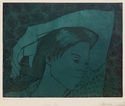
19th, 20th & 21st Century Fine Prints
707-546-7352 · fax 707-546-7924 · web: www.annexgalleries.com · email: artannex@aol.com
Blanche Grambs Biography
Blanche Grambs
American
1916–2010
Biography
Printmaker Blanche Mary Grambs was born to American parents in Beijing, China, on March 1, 1916. The granddaughter of a Baptist missionary and daughter of a businessman, Grambs’ early life was spent isolated from Chinese culture within a Westerner-dominated section of the city of Tian-Jing (then known as Tin-Sin). Surrounded primarily by Europeans and Americans in some form of a business venture or military unit, Grambs later spoke of a feeling of alienation, exacerbated by her family’s own exploitative behaviors toward the Chinese. These observations of class and race struggles would become an integral part of her work later in life.
At age thirteen, Grambs joined an informal drawing group and began spending her free time sketching portraits of willing sitters, particularly members of the Chinese working class who lived in neighboring parts of the city. She was particularly adept at pastels and at age seventeen was encouraged by artist Pearl Eastham to apply to the Art Studetns League of New York. Grambs, eager to leave, applied soon thereafter. She won a full scholarship for the 1934 academic year.
The social and cultural differences between Grambs’ birthplace and her new home were innumerable. New York in the 1930s, already the hub of Western culture, was experiencing major socioeconomic change. Among artists a sense of impending upheaval was openly discussed and embraced, as the country struggled to move out of the shadow of the Depression. It was a completely different world than she had known. Said Grambs of her arrival, “I was so sheltered…I knew things were wrong in the world but I didn’t know why.”1 The acknowledgment of the disparity among racial and economic groups mirrored her own observations growing up, however, and it wasn’t long before her art began to reflect these observations.
Social Realism was a beacon for Grambs on her newfound artistic journey. Of particular influence at the time was the work of Jose Clemente Orozco, George Grosz, and Kathe Kollwitz. Grambs was drawn to their unflinching examination of the human cost of socioeconomic oppression, and she spent her spare time studying their works in the New York Public Library. However, it wasn’t until she worked with more contemporary artists that she found her footing. Upon taking Harry Sternberg’s printmaking course she met Winifred Milius, Irving Marantz, Julian Alberts, Rita Albers, Riva Helfond, Ida Abelman, and others, including Hugh “Lefty” Miller, who she would later marry. Sternberg encouraged experimentation with print mediums and depicting real-life subject matter, two theories that remained with Grambs’ throughout her career as an artist.
In 1935 she was invited, along with a handful of other Sternberg students, to travel with him to Pennsylvania on a grant awarded Sternberg by the Guggenheim Foundation. Sternberg wanted to observe the impact of industry on the people of Lansford, where mining was rampant and notoriously harsh. This proved to be a profoundly impactful event for Grambs. The misery and exhaustion she observed became the sole focus of her prints at the time. They reflected the experience with a rougher abandon, more purposeful than her previous work, using coarse lines and deeper bites. While many of her contemporaries in New York and elsewhere portrayed industry from an aesthetic viewpoint, Grambs and her cohorts’ works came back from Pennsylvania with a firmly human, empathetic eye.
Grambs’ desire to be an agent for change was not limited to art. She studied Marxist economic theory at the New Workers School, despite not being a member of the Communist Party, and joined the Workers Film and Photo League. In 1935 she joined the Artists’ Union as the Works Progress Administration and the Federal Art Project began to take form. Through these programs she and other artists who would otherwise be unable to afford the pursuit of art were able to maintain a small studios, along with a small stipend of around $24 a week. When, in 1936, it was announced that budget cuts would lay off nearly 4,000 working artists, Grambs and the rest of the Artists’ Union occupied the Federal Art Project’s headquarters. Grambs was among the 219 that were arrested and, in coordination with the other arrestees, gave a false name—in her case, that of her grandmother, Loretta Kessler.
The spring of 1939 found a newly married Grambs and Miller en route to a new life in Paris, where Miller hoped to find cheaper living. Grambs was deeply reticent, having felt finally at home in her adopted home of New York. After summering in Brittany, they left for Paris in September only to discover that war had just been declared. As a frantic exodus of travelers and Parisians began to leave France, the couple found themselves desperately searching for a border that had not yet been closed. They eventually left Europe with the last official group of travelers. Upon their return Gramb’s discovered a changed New York, and opportunities for free exploration of art through the FAP greatly lessened. She took work as a fashion illustrator while Miller was called for duty overseas. The times had taken their toll on the young couple, however, and upon his return they divorced.
Grambs found success as an illustrator for fashion, commerce, and children’s books, and she remained active well into the 1980s. She remarried in 1952 to National Guardian co-founder James Aronson and they lived together in the Lower East Side until his death in 1988. Though she stopped printmaking in 1939, her work remains among the most important representational work of that era.
Grambs died on March 2, 2010.
Information and quotes from James Wechler’s essay on Grambs: “The Great Depression and the Prints of Blanche Grambs”, Print Quarterly XIII, 1996


